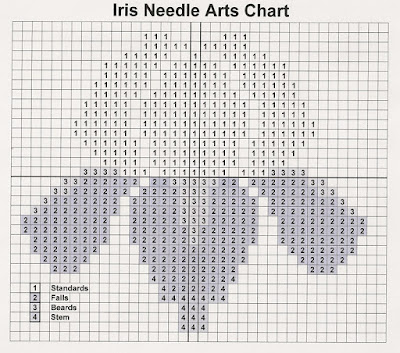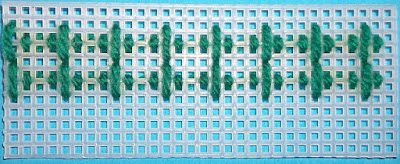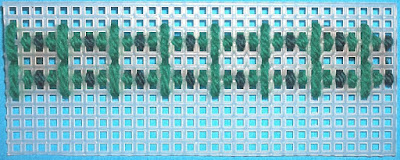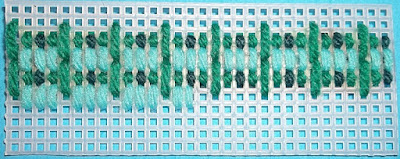| Paul Scarlett rose in Annake's garden |
I made a needlepoint from your rose chart (August 26, 2013). I know roses don't come in blue, but it is my favorite color, so I made the rose in shades from baby blue to navy and I love it! Now I'm ready to do the background and I don't want just a plain color. How can I make the background really interesting without making my rose disappear?
Bravo to you for choosing your own colors! It sounds lovely. I'm going to suggest you try a patterned background (and learn a new type of canvas work at the same time). First, look at this rose (“our” rose) done in continental stitch in tones of baby pink to burgundy. The background is a bargello pattern. Bargello is an old form of tapestry work — stitched on needlepoint canvas to provide an inexpensive fabric that looked like the much more expensive woven tapestries of the late Middle Ages. It is done in straight up-and-down stitches over a varied number of canvas threads. It is done with yarn and a tapestry needle, just like continental stitch. As you can see, the pattern did not overwhelm my rose. Blue is a cool color, so I don't recommend using the warm browns that I used for this rose. A silvery gray (you will need a light, a medium, and a darker shade) or perhaps a lavender might be a good choice. Take your rose with you so you can see the colors side by side before you buy the yarns.
 |
| Rose needlepoint with bargello background, made from chart |
I'm going to take you through the stitch process with pictures. Outline the shape of a frame on your canvas in pencil, centering your rose. You are going to begin in the upper right-hand corner of the frame, but leave an empty row of canvas squares at the top, just under the frame line, and another empty row down the right-hand side, just inside the frame line. Begin with the medium shade of your chosen color. Don't use a strand longer than 18 inches. Bring your needle up from the back in the row to the left of the empty row on the side and two rows down from the empty top row. Stitch over the thread just above where your needle entered and immediately push your needle to the back again. You have made a stitch over 1 thread. Now make a stitch that passes over the thread below your stitch, your stitch, and the thread above your stitch (3 threads in all). Moving left, make another stitch over 1 thread. You have made a design that looks like a plus mark (+). Moving left, leave an empty row, then make another plus. Continue in this pattern across the frame. If you cannot make a whole plus at the end of the row, make as much of it as you can. Your first row should look like this:
Working from either the left or the right, put a plus (or a partial plus) directly underneath each plus (or partial plus) in row 1. The tops of the second row of long stitches share the same “holes” as the bottoms of the long stitches in the first row. Rows 1 and 2 should look like this:
End your medium-colored yarn for the time being and run the end under the backs of established stitches. Thread your needle with the darkest shade of yarn. Secure the ends under the backs of some of your plus stitches. Remember those empty spaces between the horizontal arms of your pluses? Now you are going to fill them with stitches over one thread. Your first two rows should now look like this (I have used plastic canvas so that the individual stitches are easy to see):
Finally, fill in the remaining spaces with upright stitches in your lightest color. Each stitch covers 2 threads. No empty canvas shows between the stitches when you are using the size of yarn or floss appropriate for that canvas. Your completed rows should now look like this:
 |
| Detail of needlepoint rose and background interface |
As you come to the edges of your rose, do as much of each pattern stitch as the space allows. I did all the plus stitches first, to establish the vertical rows of the pattern all over the canvas. Then I did the dark stitches to establish the horizontal rows. Finally, I filled in the light stitches. You, however, may prefer to work just one row of stitches at a time. Here is an enlarged picture of an area where the background pattern meets the edge of the rose. Don't forget to fill in the empty top and side rows.
The “plus” stitch you just learned is called Hungarian stitch. I hope this project has given you an interest in bargello stitching. If so, go to the post for April 10, 2014 or use the terms “bargello” or “Hungarian stitch” in our search engine for much, much more.
I have trouble with doing needlework from charts. I keep losing my place. Any suggestions to help me?
It is certainly important to keep track of the line in the chart that corresponds with the line of stitches you are working, as well as to keep an accurate count of the number of stitches you have completed. Otherwise, your finished project may not look very much like the chart! It is a good idea to keep the chart on a flat surface where it is easy to see all of it from your working position. I use a clipboard to hold mine in place. I keep a pencil with it. If I'm interrupted or have to be away from my work for any length of time, I make a small pencil mark by my last completed stitch.
If you are primarily losing the horizontal line in the chart and are not concerned with losing count of your stitches, the simplest solution is to place a 12-inch ruler with its top edge just under the chart line you are following. If you need to add weight to the ruler to keep it in place, glue a couple of coins to the underneath side of the ruler, near the ends.
 |
| Chart and ruler |
For an easy-to-make tool to mark both the horizontal and the vertical lines in your chart, cut two pieces of stiff cardboard about 2 inches (5 cm) wide and 6 inches (15 cm) long. Staple or glue them together so that they form an L-shape. Place the L on the chart so that the bottom part of the L is directly below the horizontal line of the chart that you are following, and the upright part of the L is just behind the first stitch you are going to count. Mentally remind yourself to move the upright part of the L every 5 or 10 stitches you complete. This takes some practice, but will soon become automatic. Slide the bottom of the L up (if you are working from the bottom of the chart) or down (if you are working from the top) one space at the end of every completed row of stitches.
When I am doing latch-hook, I place my (much larger) chart above my canvas. I always start my rug or wall hanging at the bottom. At the end of each row, I turn that row of the chart under, crease it, and secure the ends with clips. I hope these suggestions make reading a chart easier.
Thanks so much for the article on counted cross-stitch (June 12, 2017). I used to do a lot of that but I haven't done any for years. Now I look forward to doing it again. Could you help me with a problem that I have always had? My floss gets twisted and I end up cutting a lot of it off and wasting it.
I'm so happy that you are going to start cross-stitching again! Encouraging people to do activities that they enjoy is one of the main aims of this blog.
First of all, I would suggest using shorter lengths of floss. I don't use anything longer than 18 inches (45 cm), whether I'm using floss or yarn. I tend to use shorter pieces of floss because the strands can separate and fray. Twelve inches (30 cm) often works better for floss. There are two ways to handle the twisting problem. The first is to hold the floss away from your work so that the needle hangs straight down. The floss should start un-twisting. Stop it before it begins to re-twist and smooth the floss between your fingertips before you begin stitching again. The second method is to put the fabric down and hold the loose end of the floss in one hand and the needle between your thumb and forefinger on the other hand. Gently slide the needle up and down the length of floss until the twists straighten out. Be careful not to fray the strands in the process. These techniques should save you both floss and frustration. Good luck!
Happy stitching.
 |
| Iris Needle Arts Chart; download from our June 18, 2015 post |
 This post by Annake's Garden is licensed under a Creative Commons Attribution-NonCommercial-ShareAlike 3.0 Unported License.
This post by Annake's Garden is licensed under a Creative Commons Attribution-NonCommercial-ShareAlike 3.0 Unported License.





No comments :
Post a Comment
Post a New Comment Below -- We Love Feedback !!!